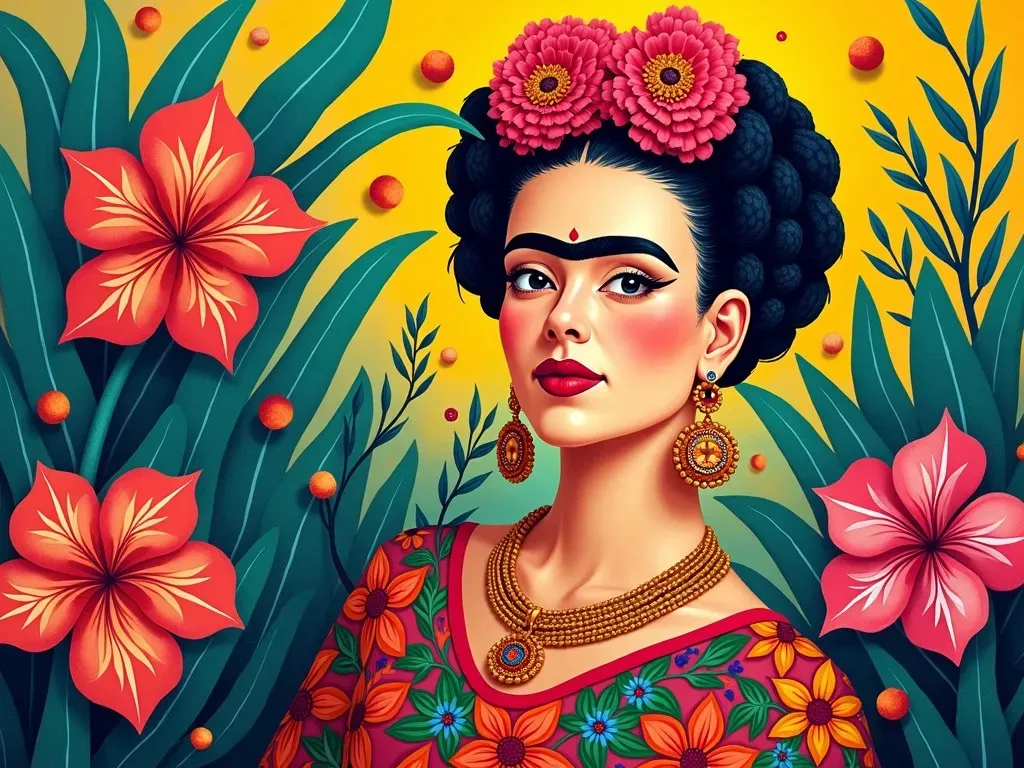Frida Kahlo, born on July 6, 1907, in Coyoacán, Mexico, was an iconic painter celebrated for her deeply personal and vibrant self-portraits and works reflecting her tumultuous life experiences. Her paintings, particularly known as “Frida Kahlo oil paintings”, are fascinating representations of her identity, suffering, and the complexities of the human experience. Today, we delve into the unforgettable legacy of Frida Kahlo through her art, exploring what makes her paintings truly exceptional.
The Signature Style of Frida Kahlo
Kahlo’s art is characterized by bold colors, intricate symbolism, and a unique blend of realism and fantasy, often inspired by Mexican culture and folklore. Her utilization of vibrant hues and emotional themes allows viewers to engage with her pain and triumphs imaginatively.
Thematic Elements in Frida’s Paintings
Identity: Kahlo frequently painted herself, reflecting her thoughts and feelings in powerful portraits that often carried symbolic meanings.
Pain and Suffering: Following a severe bus accident, which resulted in numerous surgeries and lifelong health struggles, Kahlo’s artwork became a canvas for her physical and emotional pain.
Feminism and Gender: Many of Kahlo’s pieces speak to the female experience, challenging traditional gender roles and expressing the struggles women face in a patriarchal society.
Mexican Culture: Celebrating her heritage, Kahlo infused her work with elements of Mexican history, often depicting folk art influences.
Notable Works
| Title | Year | Medium | Description |
|---|---|---|---|
| The Two Fridas | 1939 | Oil on canvas | Depicts two versions of Kahlo, representing her duality and emotional turmoil. |
| Self-Portrait with Thorn Necklace | 1940 | Oil on canvas | Highlights her pain through thorns, symbolizing suffering and sacrifice. |
| The Broken Column | 1944 | Oil on masonite | Represents Kahlo’s spine as a broken column, visualizing her physical agony. |
| Diego and I | 1949 | Oil on canvas | A complex relationship portrait between Kahlo and Diego Rivera. |
Exploring the Details of Her Art
Each painting demonstrates Kahlo’s meticulous attention to detail and emotional depth. It’s notable that many of her self-portraits, while personal, resonate universally, inviting countless interpretations.
Color Palette: Kahlo’s palette includes vivid reds, greens, yellows, and blues, mirroring the vibrancy of her life and Mexican background.
Symbolism: Use of native plants, animals, and cosmological symbols often connects her personal struggles with larger environmental and cultural narratives.
Frida Kahlo’s Influence on Contemporary Art
Kahlo’s contributions to the art world transcend her time, inspiring generations of artists, especially women, to express their identities and experiences through art. Her unique perspective and unapologetic portrayal of the female experience helped shape modern art movements and continue to influence contemporary artists across various mediums.
Where to Find Authentic Frida Kahlo Paintings
If you’re looking to buy genuine Frida Kahlo artwork or prints, there are several reputable venues and websites that offer a range of options for enthusiasts and collectors alike. Here are some places to explore:
- Frida Kahlo Foundation
- ArtNet
- Museum shops at institutions that have hosted Frida Kahlo exhibitions
Frequently Asked Questions (FAQs)
Q1: What art Techniques did Frida Kahlo use?
Frida primarily used the oil painting technique on canvas and masonite. Her style is typically categorized as folk art due to its incorporation of vibrant colors, indigenous themes, and symbolism.
Q2: Why are Frida Kahlo’s self-portraits significant?
Kahlo’s self-portraits allow her to explore personal themes, including identity, pain, and the female experience. They serve as a conduit for viewers to empathize with her struggles and triumphs.
Q3: How many paintings did Frida Kahlo create?
Frida Kahlo created approximately 200 paintings during her lifetime. Most of these are self-portraits, showcasing her evolving personal narrative.
Q4: What are some of Frida Kahlo’s most famous paintings?
Some of her notable works include:
- The Two Fridas
- Self-Portrait with Thorn Necklace
- The Broken Column
- The Wounded Deer
Q5: How did Frida Kahlo’s life experiences influence her art?
Kahlo’s life was marked by physical suffering, emotional turmoil, and complex relationships, particularly with fellow artist Diego Rivera. Her experiences fueled her creativity, leading to art that is raw and reflective of her inner and outer worlds.
The Legacy of Frida Kahlo
Over the decades since her untimely death, Frida Kahlo’s legacy has continued to grow. Her work is celebrated globally, showcased in exhibitions, documentaries, and academic studies. Frida’s ability to encapsulate her surroundings and intimate feelings into art makes her work timeless, inviting ongoing appreciation.
Conclusion
Exploring the intricacies of "Paint Frida" serves to deepen our understanding of the woman behind the canvas. Frida Kahlo’s vibrant, emotive paintings provide not only a glimpse into her life and struggles but also offer a profound connection to universal themes of identity, pain, and empowerment. Through her art, Kahlo remains an enduring figure, inspiring those who connect with her journey, both historically and contemporarily.
For in-depth information on Frida Kahlo’s artistic journey, you can also check her comprehensive biography and gallery on Britannica.
